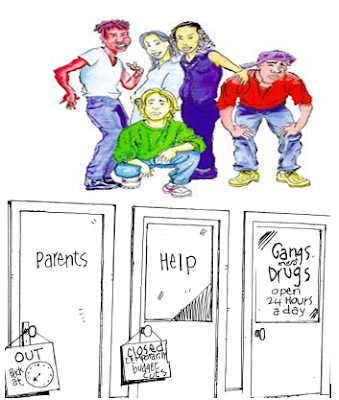For years the United States of America ranked as one of the top countries with the highest crime rate around, many would argue that it was due to the increase of gangs. Gangs have expanded so rapidly and are considered to be much more dangerous and violent now then ever before. As reported in the latest National Youth Gang Survey, “Some 788,000 gang members and 27,000 gangs were active in more than 3,550 U.S. jurisdictions in 2007. As most gang members join between the ages of 12 and 15, prevention is a critical strategy within a comprehensive response to gangs that includes intervention, suppression and reentry". With our population steadily increasing every year, there is a demand for more programs that help the youth stay out of the life of gang’s and violence.
Generally the youth is so naive and easily persuaded that in many cases if the young men and women are simply around gang members or engage in delinquent behavior that is sometimes enough to make them want to join a gang and live a lifestyle full of criminal activity. It is crucial to engage the youth in positive activities as much as possible since they tend to get in trouble and hang out with the wrong crowd when they have nothing better to do. Statistics show that peak hours for youth crime in California are during the hours of 2PM-6PM. Crime and drug use by youths is increased during these hours because of the lack of adult supervision. Since most guardians are at work during these hours, there is no way to regulate their children; thus leaving these children stranded in the community where they pick up bad habits and waste their time with the wrong crowd (fightcrime.org).
However, the youth join gangs for many different reasons. Some join gangs for respect, others for protection, some for money, and many simply because they know a friend in a gang. “A common public perception is that most youth are coerced into joining a gang. Quite to the contrary, most youth who join want to belong to a gang. Gangs are often at the center of appealing social action— parties, hanging out, music, drugs, and opportunities to socialize with members of the opposite sex. The gang may be appealing because it meets a youth’s social needs” (Howell). Regardless of what the youth’s reason for joining a gang is, a huge factor is due to parenting. When parents do not have structure in their home and let their kids do as they please without disciplining them for any bad action often those are the kids that tend to join gangs and turn to a life of crime and violence. Also when parents never show their kids love or if the kids feels that no one genuinely cares for them that tends to lead them into seeking that love somewhere else.
Despite the number of gang members being extremely high, America needs to invest more time and money on our youth instead of prisoners and prisons. We should not wait for our young men and women to get to prison to try to help them out; we should be more proactive instead of being reactive. It is inevitable youth gangs and violence will always be around, but because most youth gang members join between the age of 12 and 15 we need to focus more on preventative strategies and try to help them stay out of the life of gangs and violence to help this world be a better place for everyone.
Sources:
"California Leads the Nation in After-School Investment | FightCrime.org." FightCrime.org | 5,000 Police Chiefs, Sheriffs, Prosecutors, and Violence Survivors Preventing Crime and Violence. 11 Mar. 2010.
Web. 12 Feb. 2011. <http://www.fightcrime.org/page/californias-after-school-commitment-full-release>.
"Comprehensive Anti-Gang Initiative." Office of Juvenile Justice and Delinquency Prevention. Web. 14 Feb. 2011. <http://www.ojjdp.gov/programs/antigang/index.html>.
Howell, James C. "Gang Prevention." Juvenile Justice. U.S. Department of Justice, Dec. 2010. Web. 19 Feb. 2011. <http://www.ncjrs.gov/pdffiles1/ojjdp/231116.pdf>.
